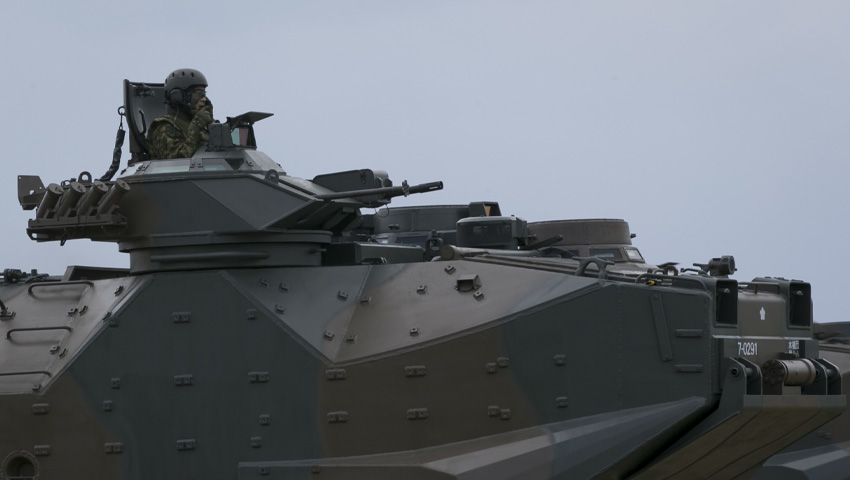With China sending a spy vessel down towards Australia in order to gather intelligence from Exercise Talisman Sabre, it is understood the main focus will be on Japan’s Amphibious Rapid Deployment Brigade (ARDB), a marine unit that serves as the guardian of Japanese islands on the edge of the East China Sea.
To continue reading the rest of this article, please log in.
Create free account to get unlimited news articles and more!
Japan's version of the US Marines, the ARDB was formally established in April last year with the capability to respond to potential attacks on remote islands around the East China Sea.
The catalyst for this of course is China's ongoing maritime assertiveness in the area, with Tokyo recognising the need for such a unit in 2006 in its Defense Programs and Budget of Japan.
Specifically, tensions over the Senkaku Islands and the Chinese Coast Guard being put under military control led to the creation of the marine unit.
The 2014 RIMPAC Exercise would see the Japan Ground Self-Defense Force (JGSDF) take part in amphibious warfare training alongside the US Marines and further training taking place two years later, with 300 personnel from the Western Army Infantry Regiment (WAIR) sent to Camp Pendleton, the major west coast base of the US Marine Corps.
These personnel were trained to prepare for the establishment of the ARDB, which took place in April last year, the first activation of a Japanese marine unit since WWII.
“Given the increasingly difficult defence and security situation surrounding Japan, defence of our islands has become a critical mandate,” Japan's Vice Defense Minister Tomohiro Yamamoto said at the launch of the ARDB.
The launch also saw the creation of a unified command for the marine unit, which eliminated the previous system of having the JGSDF being overseen by five regional armies with separate commanding generals, and headquarters for the unit was set up in the SDF's Camp Ainoura in Sasebo, Nagasaki Prefecture, with the initial staffing level at 2,100 personnel.
The ARDB saw its first official overseas deployment in October last year, with 150 personnel sent to participate alongside the US and the Philippines in Exercise Kamandag, which saw Japan land armoured vehicles on foreign soil for the first time since the Second World War, in a clear message from all three countries to China.
With the low international visibility of the ARDB (so far), it's hardly surprising that China is closely monitoring the force's capabilities at Exercise Talisman Sabre.
With the reasonably quick formation of the unit, doubts have been expressed over the initial performance of the ARDB, which has only been compounded by delays to planned vehicle acquisitions and drama surrounding plans to base V-22 Osprey aircraft at Saga Airport.
“They’ve already demonstrated the ability to put together an ad hoc Marine Expeditionary Unit (MEU). But to have a solid, standing MEU capability requires concerted effort,” Grant Newsham, a research fellow at the Japan Forum for Strategic Studies, said last year.
“If Japan put its mind to it, within a year or year and a half it could have a reasonable capability.”
Japan's Ministry of Defense had to agree to pay $130 million over 20 years to support local fishermen who expressed concerns about aircraft noise affecting their business, in order to ensure that the ARDB was able to strengthen their capability at protecting islands in the East China Sea, with the alternative being basing the Osprey's over 1,000 kilometres away, in the Chiba Prefecture.
This option, of course, would significantly lower Japan's ability to enhance deterrence against potential invasions on these islands.
Japan also faced delays over its planned AAV7 vehicle acquisitions for the ARDB, with only 15 out of 52 stationed at their base due to manufacturing delays.
The AAV7 was delayed due to a fire at a BAE Systems subcontractor, as well as a parts shortage, meaning 37 were still due to be delivered during the establishment of the ARDB.
The vehicle is also operated by the US Marine Corps, and both forces used the AAV7 at Operation Iron Fist 2019 in February, the first time the ARDB brought its own assault amphibious vehicles to the exercise between the US and Japan.
Exercise Talisman Sabre 2019, however, will be the most visible operation the ARDB will take part in, with over 34,000 personnel from the US and Australia to take part, as well as forces from Canada, New Zealand and the UK.
Delegations from India and the Republic of Korea will also observe the exercise, with a total of 18 nations from across the Indo-Pacific invited to an international visitors program.

 Login
Login







